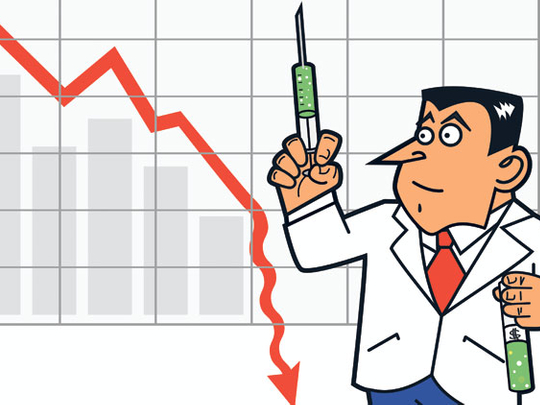
Is too much being asked of central banks now that governments are embracing austerity?
In its recent update on the world economy the International Monetary Fund (IMF) said that interest rates could and should stay low "for the foreseeable future" to mitigate the effects on aggregate demand of tighter fiscal policy.
Indeed, central banks should stand ready to do more if the recovery falters — to be "the first line of defence" against renewed recession.
That would mean holding interest rates close to zero as well as more imaginative measures such as buying government bonds.
Keeping interest rates low while fiscal support is withdrawn is a natural policy mix.
Central banks can adjust their policy settings swiftly to shifts in the business cycle, but politicians can take an age to agree upon and implement changes to taxes and to public spending.
The costs of further fiscal easing to future taxpayers are clear enough but there is no obvious cost to easy money.
The risk of rising inflation — the standard penalty for lax monetary policy — is slight given ample spare capacity in rich economies.
Savers may complain but interest rates ought to be low where there is an excess of savings and spending is weak.
Yet some economists believe that very low interest rates have costs that are easily overlooked. Raghuram Rajan, a former International Monetary Fund chief economist and professor at Chicago's Booth School of Business, is one worry wart. "We need to challenge the view that the central banks produce low interest rates and nobody gets hurt," he said.
The Bank for International Settlements (BIS), the Basel bank for central banks, has similar anxieties. A chapter in its recent annual report asks whether the hidden costs of low interest rates might be greater than the visible benefits.
The BIS identifies several dangers from too-low interest rates, including a distorted allocation of capital and workers, excessive risk-taking, lopsided balance sheets and destabilising surges in capital flows.
The bank stops short of calling for tighter monetary policy but it warns that "keeping interest rates low comes at a cost — a cost that is growing with time".
Perhaps the least troubling of these risks is the potential for distortions of allocation, whereby some parts of the economy are overstimulated by low interest rates.
This was a concern in 2002-04 when low short-term interest rates boosted house prices and diverted workers and capital into construction and property ventures.
Many of those investments proved unwise and the jobs that went with them did not last.
It is harder today to point to bits of the rich world's economy that have been stimulated by low interest rates in this way (although finance might be one).
Nor is it clear that risk-taking has yet gone too far. Cutting interest rates is supposed to arrest steep falls in asset prices, and to persuade businesses and savers to stop clinging to the safety of cash and instead make riskier investments that help economic growth.
It is tricky to judge when this necessary check on undue caution turns into an incitement to recklessness. Before Europe's debt crisis began to unnerve investors Rajan detected the "preliminary stirrings" of excess risk-taking in the return of covenant-light loans and tighter credit spreads on junk bonds.
Such frothiness may return if anxieties about Europe's banks are resolved by official stress tests.
But as things stand, housing markets in most rich economies look depressed, credit growth remains weak and stockmarkets have lost some of their earlier zest.
Low interest rates can have more insidious effects on balance-sheets. The BIS frets that companies and governments might load up on short-term debt to cut borrowing costs; in fact, they seem to be doing the opposite.
Concern
Banks may be more of a concern, as they borrow at shorter maturities to lend at longer ones. This is a profitable strategy when, as now, short-term interest rates are close to zero and the yields on longer-term bonds are higher.
Indeed, low rates are a semi-deliberate subsidy to help nurse banks back to health. But if money is kept cheap for too long banks may be tempted to borrow excessively to fund long-term bonds, risking capital losses should interest rates suddenly rise.
Cheap money may also delay a cleaning-out of bad debts from the banking system. The BIS report points out that a long period of low interest rates in Japan during the 1990s allowed banks to refinance loans that ought to have been written off.
As long as firms could pay the low servicing costs on dud loans, banks could pretend that the principal might one day be repaid. This "evergreening" of loans holds up the repair of the banking system and keeps zombie firms alive at the expense of more efficient competitors or new start-ups. Bank supervisors should be responsible for stamping out this practice but they may be as loth to admit to past mistakes as the banks are themselves.
Low interest rates in the rich world can impose costs on poorer countries. The Federal Reserve and the European Central Bank determine the world's short-term interest rate, Rajan said. But that rate was often unsuitable for other economies. Near-zero rich-world rates encourage yield-hungry investors to place their short-term funds in emerging markets. That is a headache for central banks in those countries, which find that raising rates to cool their economies only encourages speculative inflows.
These anxieties have some basis but seem rather small compared with the bigger fear that recovery may falter as government support to the economy is scaled back. The worrywarts have a stronger point when they argue that too much emphasis is placed on short-term interest rates as a means of cutting unemployment. "The cautionary tale from Japan is that keeping interest rates low without doing anything to fix structural problems may have little effect," Rajan said.
That may not yet add up to an argument for higher interest rates. But fresh thinking about ways to help the jobless get the skills they need might stop people expecting miracles from central banks.












